- Home
- Quizzes
- My Quiz Activity
- Newsletters
- Sports Betting
- MY FAVORITES
- Add Sports/Teams
- SPORTS
-
NFL
- NFL Home
- Arizona Cardinals
- Atlanta Falcons
- Baltimore Ravens
- Buffalo Bills
- Carolina Panthers
- Chicago Bears
- Cincinnati Bengals
- Cleveland Browns
- Dallas Cowboys
- Denver Broncos
- Detroit Lions
- Green Bay Packers
- Houston Texans
- Indianapolis Colts
- Jacksonville Jaguars
- Kansas City Chiefs
- Las Vegas Raiders
- Los Angeles Chargers
- Los Angeles Rams
- Miami Dolphins
- Minnesota Vikings
- New England Patriots
- New Orleans Saints
- New York Jets
- New York Giants
- Philadelphia Eagles
- Pittsburgh Steelers
- San Francisco 49ers
- Seattle Seahawks
- Tampa Bay Buccaneers
- Tennessee Titans
- Washington Commanders
-
MLB
- MLB Home
- Arizona Diamondbacks
- Atlanta Braves
- Baltimore Orioles
- Boston Red Sox
- Chicago White Sox
- Chicago Cubs
- Cincinnati Reds
- Cleveland Guardians
- Colorado Rockies
- Detroit Tigers
- Houston Astros
- Kansas City Royals
- Los Angeles Angels
- Los Angeles Dodgers
- Miami Marlins
- Milwaukee Brewers
- Minnesota Twins
- New York Yankees
- New York Mets
- Oakland Athletics
- Philadelphia Phillies
- Pittsburgh Pirates
- San Diego Padres
- San Francisco Giants
- Seattle Mariners
- St. Louis Cardinals
- Tampa Bay Rays
- Texas Rangers
- Toronto Blue Jays
- Washington Nationals
-
NBA
- NBA Home
- Atlanta Hawks
- Boston Celtics
- Brooklyn Nets
- Charlotte Hornets
- Chicago Bulls
- Cleveland Cavaliers
- Dallas Mavericks
- Denver Nuggets
- Detroit Pistons
- Golden State Warriors
- Houston Rockets
- Indiana Pacers
- Los Angeles Clippers
- Los Angeles Lakers
- Memphis Grizzlies
- Miami Heat
- Milwaukee Bucks
- Minnesota Timberwolves
- New Orleans Pelicans
- New York Knicks
- Oklahoma City Thunder
- Orlando Magic
- Philadelphia 76ers
- Phoenix Suns
- Portland Trail Blazers
- Sacramento Kings
- San Antonio Spurs
- Toronto Raptors
- Utah Jazz
- Washington Wizards
-
NHL
- NHL Home
- Anaheim Ducks
- Arizona Coyotes
- Boston Bruins
- Buffalo Sabres
- Calgary Flames
- Carolina Hurricanes
- Chicago Blackhawks
- Colorado Avalanche
- Columbus Blue Jackets
- Dallas Stars
- Detroit Red Wings
- Edmonton Oilers
- Florida Panthers
- Los Angeles Kings
- Minnesota Wild
- Montreal Canadiens
- Nashville Predators
- New Jersey Devils
- New York Islanders
- New York Rangers
- Ottawa Senators
- Philadelphia Flyers
- Pittsburgh Penguins
- San Jose Sharks
- Seattle Kraken
- St. Louis Blues
- Tampa Bay Lightning
- Toronto Maple Leafs
- Vancouver Canucks
- Vegas Golden Knights
- Washington Capitals
- Winnipeg Jets
- NCAAF
- NCAAM
- Boxing
- Entertainment
- Lifestyle
- Golf
- MMA
- Soccer
- Tennis
- Wrestling
- More Sports
- RESOURCES
- My Account
- YB on Facebook
- YB on Twitter
- YB on Flipboard
- Contact Us
- Privacy Policy
- Terms of Service

The best small-school quarterbacks in NFL history
While first-round picks or players from well-established college programs represent the bulk of the quarterback position's all-time greats, several have taken the long way to NFL prominence. Here are the top QBs to come out of small schools -- be it low-level Division I programs or non-Division I schools -- in the common draft era (1967-present).
Ken Anderson, Augustana College
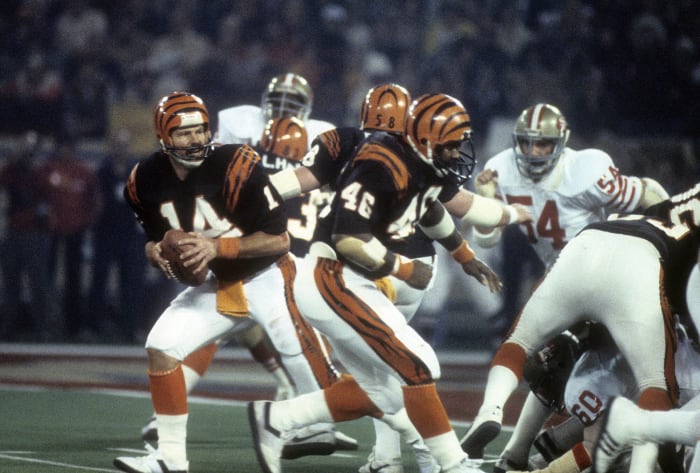
His era's most accurate passer, Anderson arrived in the NFL out of Augustana College (Illinois). Mike Brown and then-Bengals QBs coach Bill Walsh recommended Paul Brown take Anderson in Round 2, but the Bengals founder waited until the 1971 third round to nab the atypical prospect. Anderson filled the void created by Bengals 1969 first-rounder Greg Cook's career-ending shoulder injury, supplanting Virgil Carter as Cincinnati's starter and keeping the reins until Boomer Esiason's emergence. Anderson was the triggerman for what became the West Coast Offense, later winning the 1981 MVP while guiding the Bengals to Super Bowl XVI.
Terry Bradshaw, Louisiana Tech
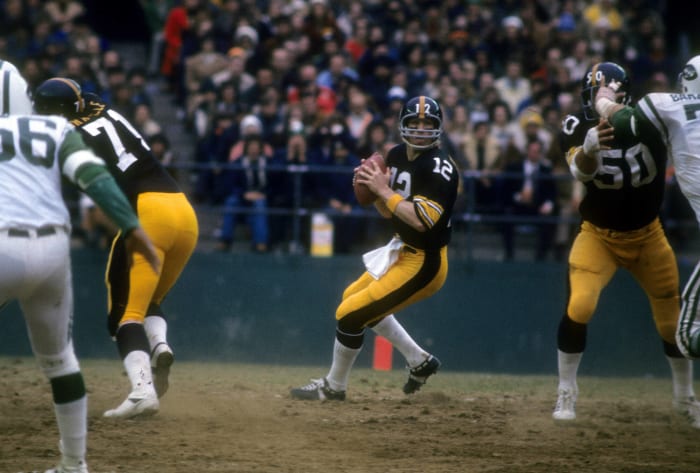
Small-school quarterbacks have landed in the top five on a few occasions, but Bradshaw's No. 1 overall status stands alone in the common draft era. Coming out of Louisiana Tech, the future FOX mainstay was not squarely on the first-round radar. He went to Pittsburgh first overall only because the Steelers won a coin toss with the Bears to determine the top pick. It took Bradshaw a while to find his footing in a tough era for quarterbacks; he was benched during the 1974 Super Bowl IX campaign. But the non-Division I prospect joins Joe Montana and Tom Brady as four-time Super Bowl-winning QBs.
Daunte Culpepper, Central Florida
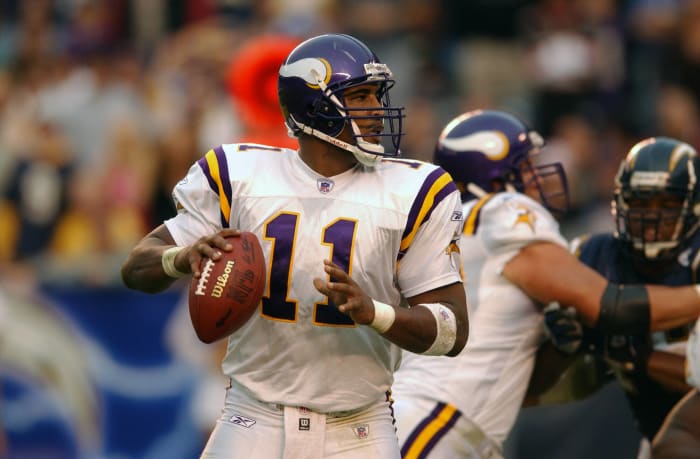
While Central Florida has enjoyed success as a Group of Five program, stationed in the American Athletic Conference presently, Culpepper played for the school's first Division I teams. The Knights moved up from what was then Division I-AA in 1996, Culpepper's sophomore year, and their hulking quarterback became a first-round prospect over the next three seasons. Despite Randall Cunningham's first-team All-Pro 1998 season, the Vikings used the No. 11 overall pick they obtained by sending Brad Johnson to Washington to draft Culpepper. The 1999 first-rounder sat behind Jeff George as a rookie but made three Pro Bowls in six years as Minnesota's QB1.
Steve DeBerg, San Jose State
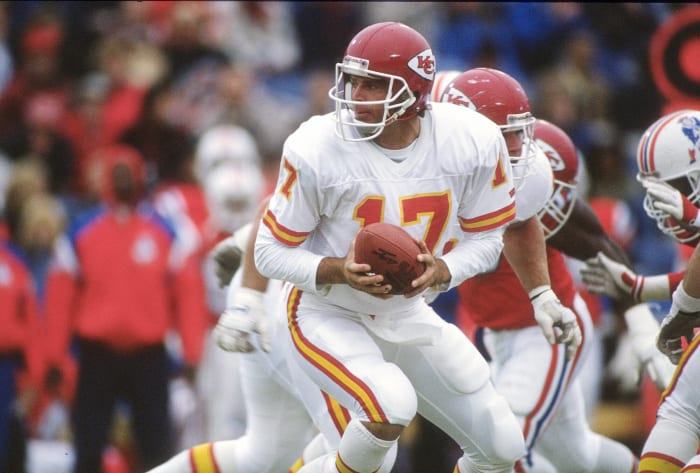
DeBerg began his college career in 1972; he was still in the NFL by 1998. While this is deceiving, as the journeyman/QB groomer took a few years off, the San Jose State alum covered considerable ground as a pro. The Cowboys drafted DeBerg in the 1977 10th round but waived him before the season. DeBerg soon caught on with the 49ers, later becoming Joe Montana's placeholder. The Broncos traded for DeBerg in 1981, and he ended up playing the same role alongside John Elway. The Buccaneers later kept DeBerg around to start Vinny Testaverde's career. DeBerg's most notable stretch came with the Chiefs, whom he quarterbacked to the playoffs in 1990 and '91.
Jake Delhomme, Louisiana-Lafayette
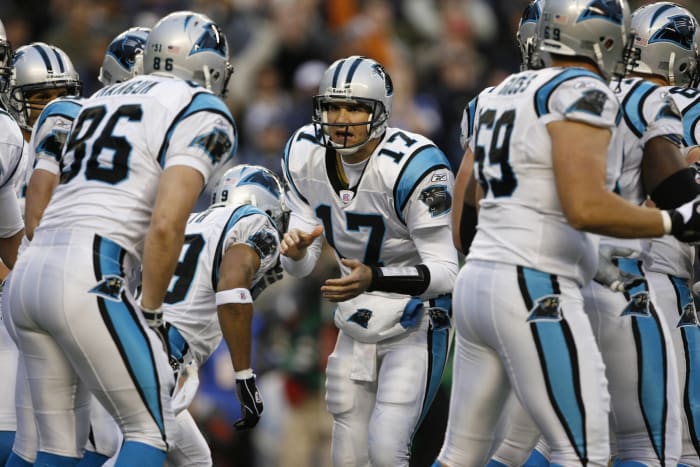
Playing for what is now known simply as Louisiana University, Delhomme saw several years pass between his Ragin' Cajun seasons and a legitimate NFL starter opportunity. Delhomme wrapped his college career in 1996; his Panthers debut did not happen until 2003. After backing up Kurt Warner in NFL Europe, Delhomme was a Saints afterthought for years. The Panthers gave him a two-year deal in 2003 to succeed Rodney Peete; the southern QB led Carolina to Super Bowl XXXVIII that season and nearly won a duel against Tom Brady. Delhomme piloted the Panthers to two more playoff brackets as their starter through the 2009 season.
Ryan Fitzpatrick, Harvard

Its hallowed academic status notwithstanding, Harvard qualifies as small for football purposes. The Ivy League program produced one of the NFL's iconic journeymen in Fitzpatrick, who is the only quarterback to ever start for nine NFL teams. The 2005 seventh-round pick played for the Rams, Bengals, Bills, Titans, Texans, Jets, Buccaneers, Dolphins, and Washington from 2005-21, producing a host of memorable moments -- the Jets TD pass record (2015), #Fitzmagic in Tampa and preventing the 2019 Patriots from a first-round bye despite leading a terrible Dolphins team -- as his beard expanded.
Joe Flacco, Delaware
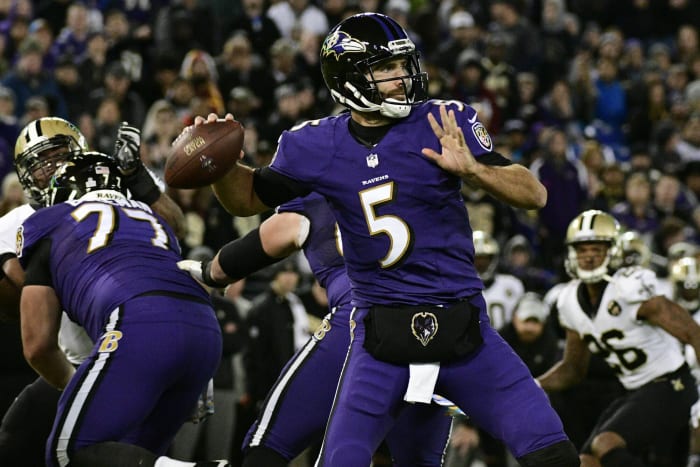
Though wildly scrutinized, Flacco is a Super Bowl MVP who has played 15 NFL seasons. After transferring from Pittsburgh to Delaware, Flacco joined Matt Ryan as 2008's first-round quarterbacks. His arrival gave the Ravens their first long-term quarterback, coming after the franchise's Kyle Boller misstep and Steve McNair's injury-prone 2007 led to Brian Billick's firing. Flacco and John Harbaugh's partnership produced five straight playoff berths and three trips to the AFC championship round in that span. Lamar Jackson is more talented, but he has a ways to go to match Flacco for Raven longevity (11 seasons).
Rich Gannon, Delaware
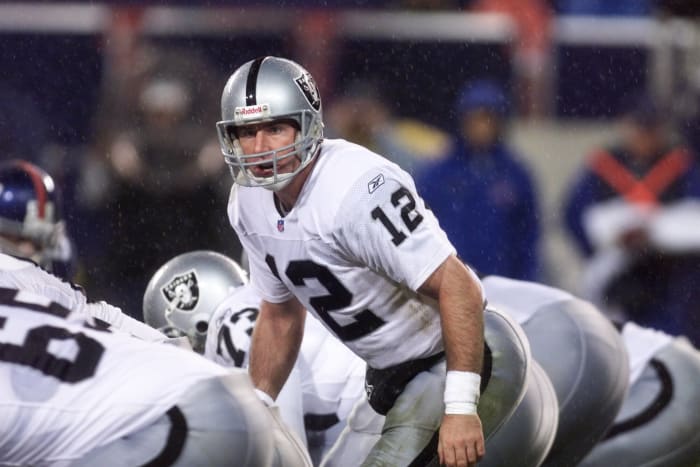
After Gannon quarterbacked a run-oriented Delaware offense, the Patriots traded up to draft him in the 1987 fourth round. New England's staff envisioned the Division I-AA product as a utility player of sorts, viewing him at a few non-quarterback spots. Gannon refused to sign and was traded to the Vikings after barely a week. Gannon's steadfastness proved correct, though he did not secure a long-term starting job for another decade. After intermittent starter stints with the Vikings and Chiefs, Gannon signed with the Raiders in 1999. Two All-Pro nods and a 2002 MVP honor followed, capping one of the latest-blooming runs in QB history.
Jeff Garcia, San Jose State

A Big West program when Garcia played there in the early 1990s, San Jose State later moved up in the ranks and is now a Mountain West team. The Spartans have produced multiple longtime NFL starting QBs. No team drafted the undersized passer in 1994, leading to a five-year Canada stay. Garcia did not become a starter in Canada until his third year, backing up CFL deity Doug Flutie in Calgary (though, Garcia's CFL run did come up in "Young Rock" episodes). Steve Young's career-ending concussion threw the 1999 49ers free agent into the NFL fire after three games. Young's injury led to a five-year 49ers QB1 run for Garcia, who started 116 games with five teams.
Jimmy Garoppolo, Eastern Illinois
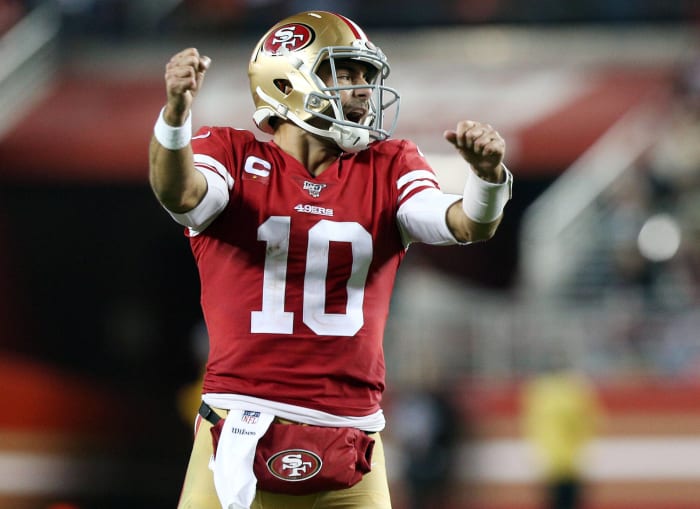
The Patriots made Garoppolo the highest-drafted QB (No. 62 overall) of the Tom Brady era, but the all-time great held off his would-be heir apparent into his 40s. Beyond Brady's Deflategate ban, Garoppolo sat throughout his Patriots tenure. A reported Robert Kraft-Bill Belichick disagreement led to the Pats changing their Garoppolo trade stance at the 2017 deadline, and the 49ers obtained him for a second-round pick. Garoppolo injuries defined the 49ers of recent years, but he went 38-17 as San Francisco's starter, played in two NFC championship games and Super Bowl LIV. Reuniting Garoppolo with Josh McDaniels, the Raiders will bet on the form he showed when healthy.
James Harris, Grambling State
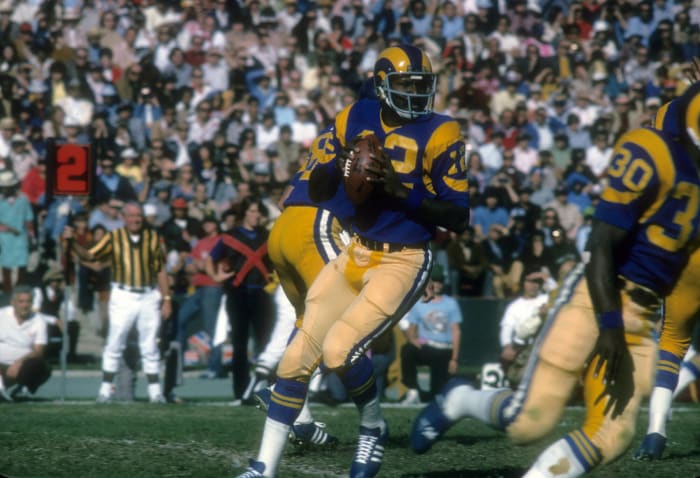
Chosen by the Bills in the 1969 eighth round, Harris sat behind AFL champion Jack Kemp and then Dennis Shaw during three Buffalo seasons. Not factoring in prominently in Buffalo, Harris made history in Los Angeles. After the Bills cut him, Harris caught on with the Rams and became the first Black quarterback to start a playoff game -- a divisional-round win over Washington. Harris made the Pro Bowl for his work during that 1974 season, one in which he replaced 1973 Pro Bowler John Hadl. While Harris drifted to part-time starter status by 1976, he made important contributions to the game.
Jim Hart, Southern Illinois
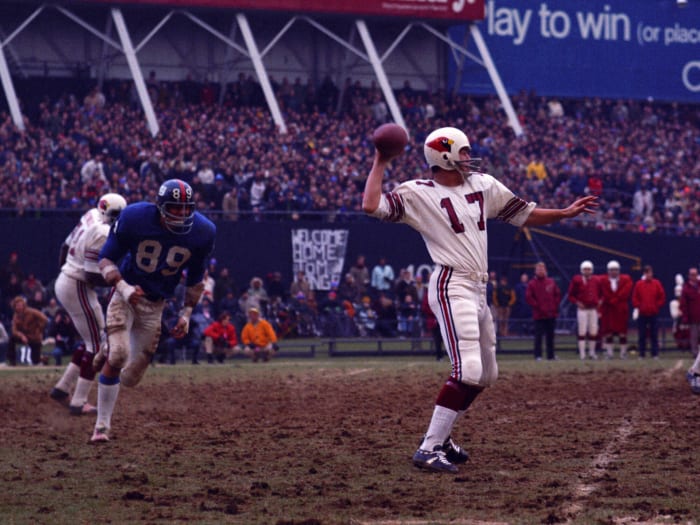
Undrafted by both the NFL and AFL in 1966, despite those drafts being 20 rounds apiece, Hart caught on with the St. Louis Cardinals as a tryout body. The ex-Saluki lasted 19 seasons and retired third on the NFL's all-time passing yards list. Hart usurped longtime Cardinals starter Charley Johnson in 1967 and remained in the role until 1981. Hart's numbers spiked in the mid-1970s when playing under pass-happy coach Don Coryell, and he made four Pro Bowls during Coryell's stay. Despite Roger Staubach being in his prime at this point, the Cards won the NFC East in 1974 and '75.
Jon Kitna, Central Washington
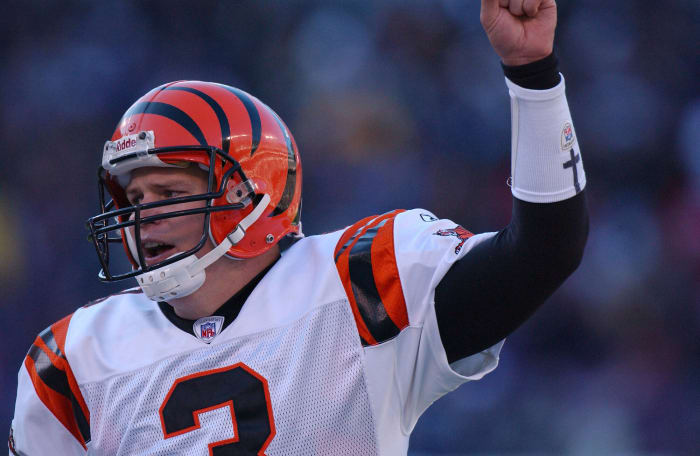
The rare NAIA quarterback to enjoy a notable NFL career, Kitna served a multiyear apprenticeship before taking the reins of his hometown Seahawks. The Tacoma native played at Central Washington and caught on as an undrafted player with the Seahawks in 1997. Seattle had pulled the plug on Rick Mirer and used 41-year-old Warren Moon as its starter that year. Moon was the team's primary 1998 starter as well. Mike Holmgren's 1999 arrival coincided with Kitna's promotion, though Holmgren traded for ex-Packer charge Matt Hasselbeck in 2001. Kitna lasted until 2011, bouncing around the NFL until his age-39 season.
Dave Krieg, Milton College

Krieg's college, Milton (Wisconsin), folded in 1982. He is the only Milton alum to play more than one NFL season. Undrafted out of the Division III program in 1980, Krieg did not overtake incumbent Jim Zorn until his fourth season. Zorn had been the franchise's starter since its 1976 inception, but Krieg was at the controls when the team made its first playoff berth in 1983. Despite coming from college football's bottom tier, Krieg led the Seahawks to three more postseasons during the '80s and guided the Chiefs (1992) and Lions (1994) to playoff games over the course of a 19-year career.
Greg Landry, Massachusetts
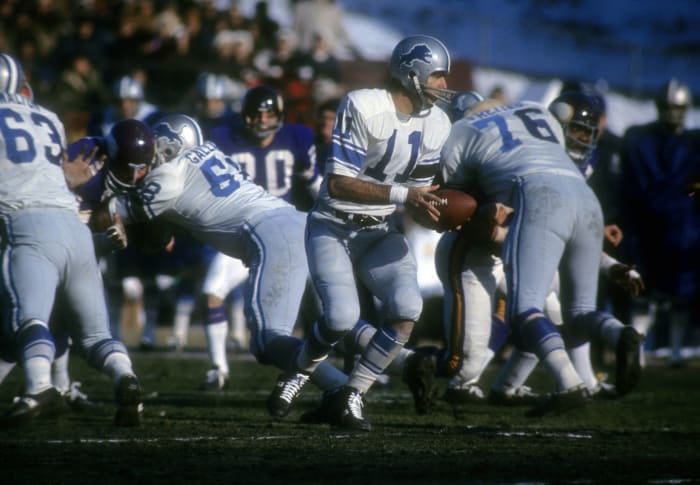
Landry bounced in and out of Detroit's starting lineup and did not live up to his draft pedigree (11th overall in 1968), but he took a struggling franchise to the playoffs, made two Pro Bowls and played 15 seasons. The first quarterback off the board in a draft that included Ken Stabler and Mike Livingston, Landry led the Lions to the playoffs in 1971. This was Detroit's only postseason appearance between 1957 and 1983. Losing the job to Bill Munson at points in the mid-1970s, Landry resurfaced with a Comeback Player of the Year season in 1976.
Neil Lomax, Portland State
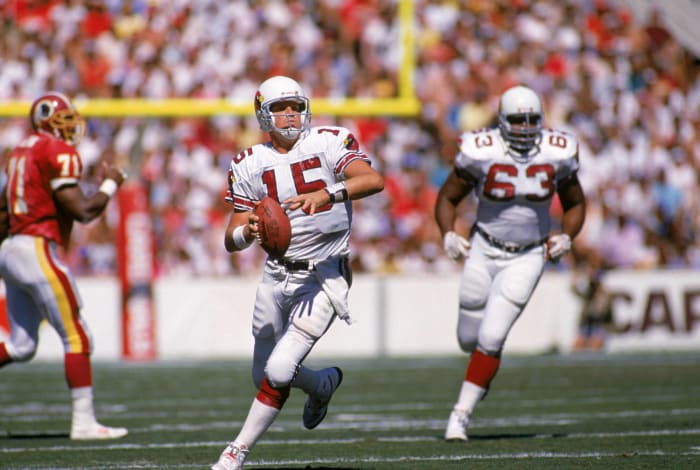
The Cardinals replaced one small-school quarterback with another. Arriving from the Division I-AA level in 1981, Lomax took over for Southern Illinois success story Jim Hart full-time in his second season. Lomax was one of the first quarterbacks to play for Run and Shoot innovator Mouse Davis, posting huge numbers in the cutting-edge passing system in college. This led to him becoming 1981's first QB selected (33rd overall). Dropped into a tough NFC East, Lomax still made two Pro Bowls -- the first after he threw for 4,618 yards in 1984, then the best non-Dan Marino/Dan Fouts total ever -- and started until a 1988 hip injury ended his career.
Steve McNair, Alcorn State
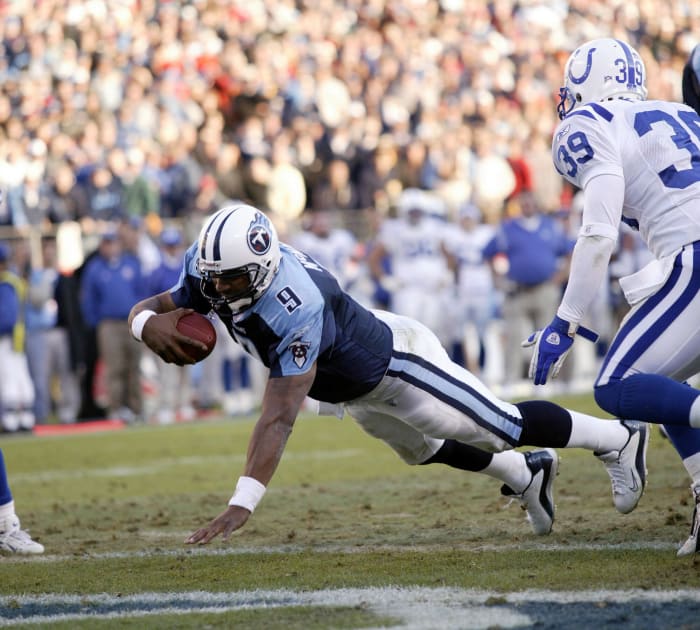
The 1994 Oilers went 2-14 but only held the No. 3 pick in 1995, thanks to the Jaguars and Panthers' arrivals. Jacksonville chose Tony Boselli first overall, and Carolina chose a quarterback with its first pick. The Panthers traded down from No. 2, however, and took Kerry Collins at 5. The future Titan did not pan out in Carolina; his small-school draft classmate did in Tennessee. Houston chose the Alcorn State QB with the preposterous senior-season stat line (5,799 yards of total offense), and McNair led the franchise to its only Super Bowl and shared the 2003 MVP award. Tennessee signed Collins to back up Vince Young just after McNair's 2006 exit.
Ken O'Brien, California-Davis
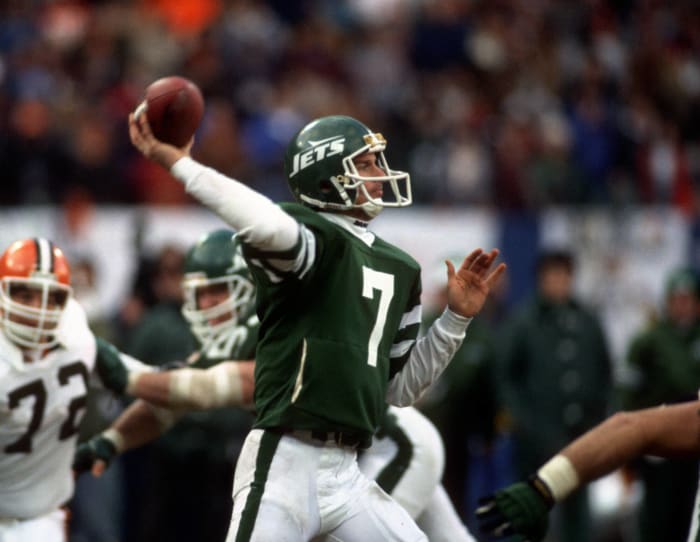
Being the fourth-best quarterback in a draft class sounds bad, but ranking behind John Elway, Dan Marino, and Jim Kelly: less bad. The Jets missed on Marino, making O'Brien (24th overall) the fifth QB picked in that historic first round. But the 6-foot-4 passer was not not a bust in the Big Apple. In eight years as a starter, O'Brien led the Jets to three playoff berths and earned two Pro Bowl nods. Richard Todd's successor outdueled Marino in a classic September 1986 shootout and threw 25 touchdown passes in back-to-back years (1985 and '86). O'Brien's 106 starts trail only Joe Namath (125) among Jets QBs.
Dan Pastorini, Santa Clara
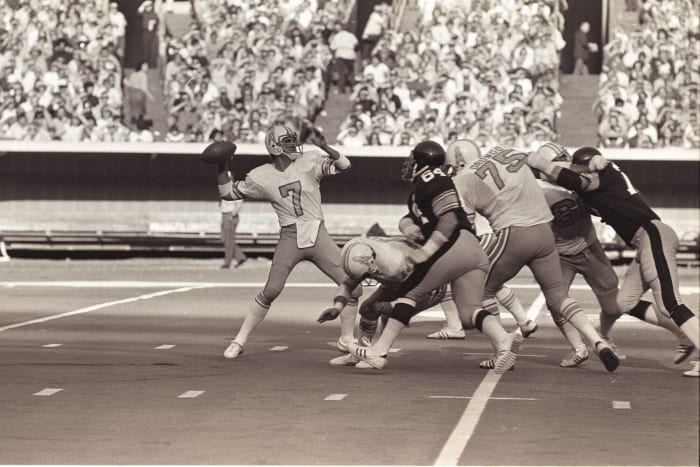
After the Patriots took Heisman winner Jim Plunkett and the Saints landed Ole Miss star Archie Manning to start the 1971 draft, the Oilers made it the first QB-QB-QB start to a draft by selecting Pastorini. Houston was still in search of a long-term George Blanda successor, after trying multiple veteran options in the years prior, but the team hedged its Pastorini bet by drafting Kansas State's Lynn Dickey in Round 3. Houston held onto Dickey for four seasons before flipping him to Green Bay in 1976. Though sacked so often he became famous for wearing a flak jacket, Pastorini piloted the Oilers to two AFC title games.
Chad Pennington, Marshall
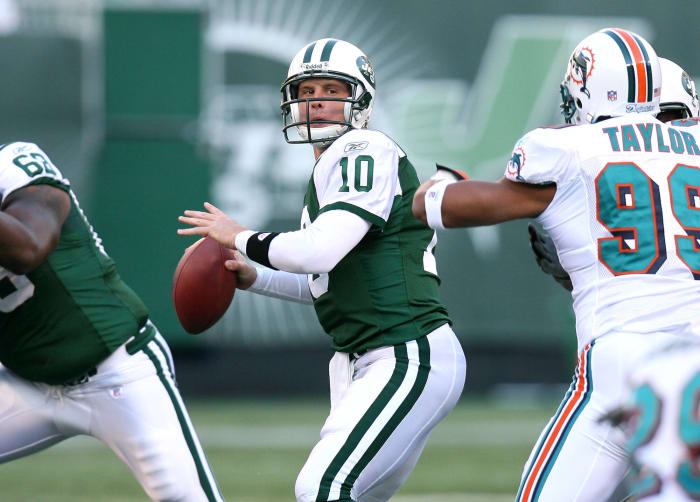
Pennington was Marshall's quarterback when the school made its transition from Division I-AA to the Mid-American Conference. Randy Moss' final college QB started as a true freshman, leading the Thundering Herd to a I-AA national championship game, but redshirted his second season due to a Florida transfer taking his job. Pennington recaptured the gig in 1997, teaming with Moss, and earned Heisman votes as a senior in 1999. The Jets took Pennington in the 2000 second round and sat him for two seasons behind Vinny Testaverde. Limited arm strength did not deter Pennington -- a two-time Comeback Player of the Year award recipient -- from leading the Jets to three playoff berths from 2002-06.
Ben Roethlisberger, Miami (Ohio)
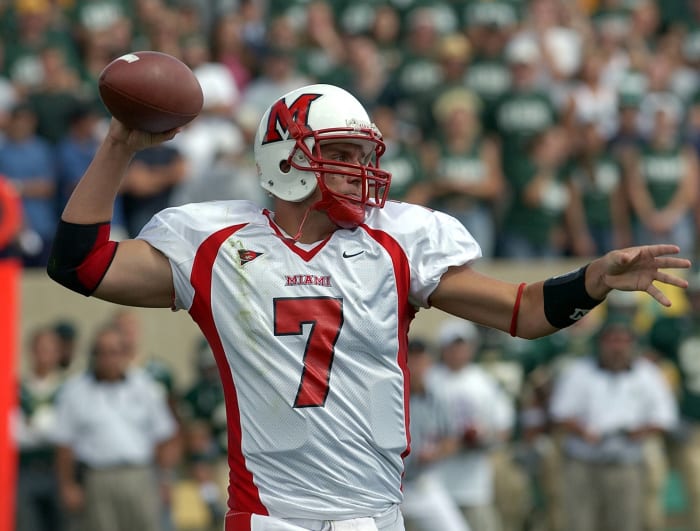
Roethlisberger entered the 2004 draft after his junior year at a MAC program, having sported a 37-10 TD-INT ratio at Miami (Ohio) University in 2003. After 2002 Comeback Player of the Year Tommy Maddox regressed in '03, the Steelers acquired the player who became the longest-tenured starter in team history. A less-big Ben went 11th overall, after the Eli Manning-Philip Rivers switcheroo, and replaced an injured Maddox in Week 3 of his rookie year. Roethlisberger started 270 games (counting 23 playoff outings) over the next 18 seasons, which left the Steelers with a much tougher QB-replacement task after his 2022 retirement.
Tony Romo, Eastern Illinois
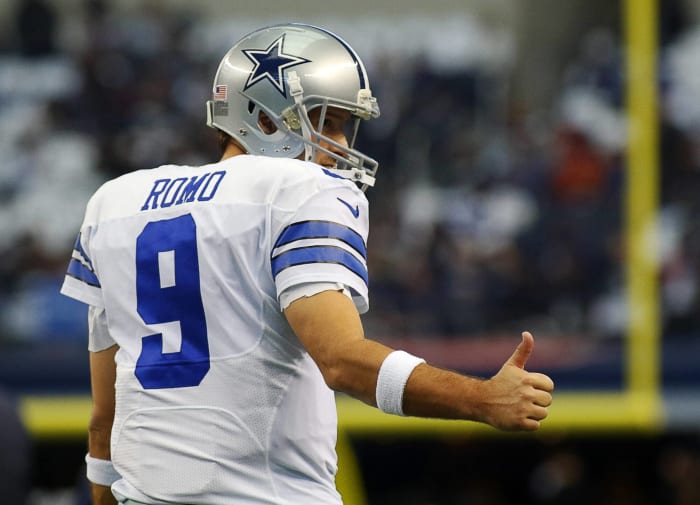
Romo's three Ohio Valley Conference Player of the Year honors did not lead to a draft investment, but he landed with the Cowboys in Bill Parcells' first year. Fellow Eastern Illinois alum Sean Payton was on Dallas' staff at that point as well, helping the younger Division I-FCS passer's cause. Quincy Carter, a 40-year-old Vinny Testaverde, and Drew Bledsoe proceeded to quarterback the Cowboys from 2003-05, but Parcells inserted Romo into an October Monday-night game in 2006. No quarterback has been with the Cowboys longer than Romo, a four-time Pro Bowler during a 14-year stay.
Phil Simms, Morehead State
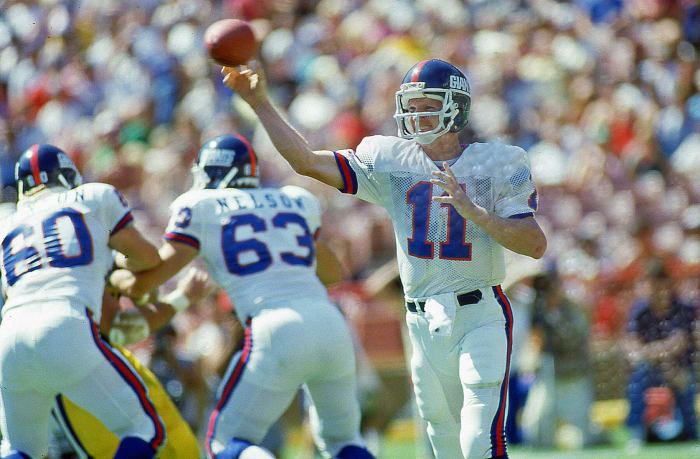
Herm Edwards' "Miracle at the Meadowlands" touchdown in November 1978 caused the Giants to fire their offensive coordinator the next day and can head coach John McVay after the season. They hired a new GM, eventual Hall of Famer George Young, in 1979 as well. The new regime pinned hopes on a Morehead State quarterback, choosing Simms seventh overall. The future announcer enjoyed a rocky run to start his career, being replaced by 1980 sixth-rounder Scott Brunner for all of 1982 and most of 1983. Simms righted the ship by '84 and was the Super Bowl XXI MVP two years later. Simms played 16 seasons.
Kurt Warner, Northern Iowa
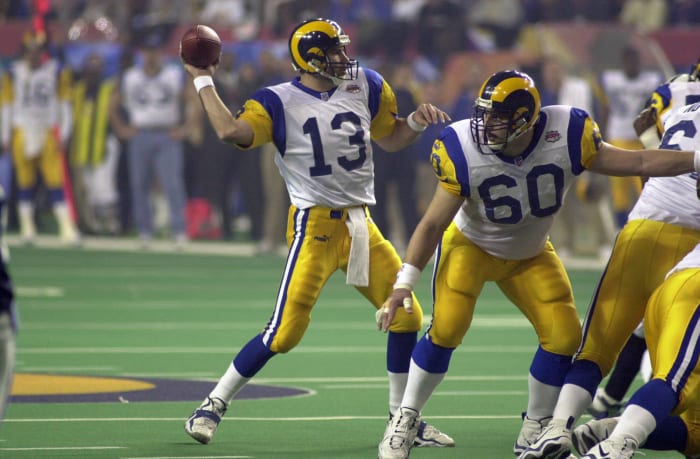
Warner's journey between Northern Iowa and the Rams is quite well known. A movie now chronicles this five-year detour that involved a grocery store job and work in two other leagues. The Rams' mid-'90s: less discussed. They cycled through multiple vets (Chris Miller, Chris Chandler) before the Tony Banks period and carried Warner as a Banks backup throughout 1998. Warner's transcendent 1999 happened after Trent Green's four-year, $16.5M deal preceded a preseason ACL tear. Warner's two MVPs aside, he was only the Rams' full-time starter for four seasons; he was benched for Marc Bulger in 2003. His Cardinals comeback aside, the Hall of Famer will always be linked to the Rams.
Carson Wentz, North Dakota State
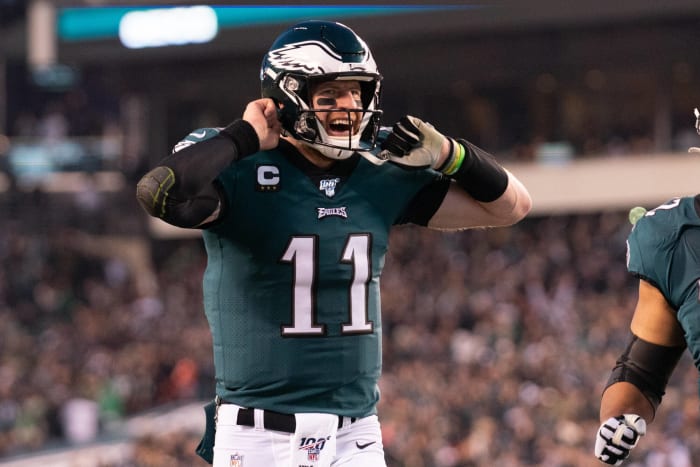
Wentz has trended downward, bottoming out after Colts owner Jim Irsay backed multiple buses over him during an offseason in which the team traded him to the Commanders, who joined the Colts in jettisoning him after one season. The Division I-FCS champion's stock soared in 2016, when the Eagles traded up with the Browns to land him at No. 2 overall. Given their climb from 7-9 to the NFC's No. 1 seed in 2017, it is arguable Wentz still should have won the 2017 MVP award despite his early-December ACL tear. Wentz then led a severely shorthanded Eagles team to the 2019 playoffs, but his career has hit a crossroads.
Doug Williams, Grambling State

Although never a Pro Bowler, Williams proved his chops by guiding Washington to the Super Bowl XXII title. The Grambling product initially landed in a brutal spot, going to the Buccaneers in the 1978 first round. To that point, the Bucs were 2-26 as a franchise. Backed by a strong defense, Williams had them in the 1979 NFC title game, making for one of the most shocking runs in NFL history. After a messy Bucs divorce, a retirement, and a USFL stay, Williams resurfaced in Washington and usurped Jay Schroeder in 1987. The first Black QB to win a Super Bowl led a 35-point second quarter in Washington's demolition of Denver.
Sam Robinson is a Kansas City, Mo.-based writer who mostly writes about the NFL. He has covered sports for nearly 10 years. Boxing, the Royals and Pandora stations featuring female rock protagonists are some of his go-tos. Occasionally interesting tweets @SRobinson25.
More must-reads:
- Falcons trade up in second round, draft Clemson DL at No. 35
- Rams trade up in second round, select another FSU DL at No. 39
- The '100 catches in an NFL season' quiz
Breaking News
Customize Your Newsletter
 +
+
Get the latest news and rumors, customized to your favorite sports and teams. Emailed daily. Always free!
Use of this website (including any and all parts and
components) constitutes your acceptance of these
Terms of Service and Privacy Policy.

